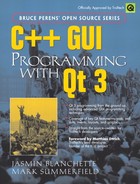Book Description
"...not only the best book on Qt I have ever seen, but also the best book presenting any programming framework. Every sentence appears to be carefully worded, and every chapter has a sound concept, and so does the work as a whole." --Matthias Ettrich, Trolltech's lead developer, founder of the KDE project
"The 'Tao of Qt'.... The Qt system is a beautiful example of object oriented design, and the authors take advantage of this.... The authors have done an excellent job of presenting the subject in an interesting and engaging way...." --Ron McCarty, Instructor and Chair of the Department of Computer Science, Penn State Erie, The Behrend College
The first official Trolltech guide to Qt 3.2 programming!
Straight from Trolltech, this book covers all you need to build industrial-strength applications with Qt 3.2.x and C++--applications that run natively on Windows, Linux/Unix, Mac OS X, and embedded Linux with no source code changes! The book teaches solid Qt programming practices; it is not a rehash of the documentation.
Build powerful C++ GUI applications quickly and easily
Design dialogs and main windows visually and in code
Learn Qt's innovative typesafe signals and slots mechanism
Use layouts to create forms that automatically size and scale
Create custom signals, slots, events, and controls
Program the ''Qt way'' with techniques for Qt 3.2 that'll work with Qt 4
Code applications with menus, toolbars, dialogs, and drag and drop
Utilize 2D and 3D graphics, multithreading, and networking
Write database and XML applications
Internationalize to reach foreign markets
Exploit platform-specific-features like ActiveX
Already using Qt or just starting out? Evaluating Qt or managing it? Building open source applications--or commercial applications? Want to develop for Windows without buying an expensive compiler? Whatever your goal, this is the only book you need!
Table of Contents
- Copyright
- Bruce Perens’ Open Source Series
- Foreword
- Preface
- Acknowledgments
- A Brief History of Qt
- About the Authors
- Production
- About the CD-ROM
- I. Basic Qt
- II. Intermediate Qt
